When it comes to natural hair color, beauty isn’t about following a trend-it’s about harmony. The most beautiful natural hair color for a woman isn’t the one everyone else has, but the one that fits her skin, her features, and her life. And right now, the data shows something clear: brunette hair is leading the pack-not because it’s trendy, but because it just works.
Why Brunette Hair Dominates in 2025
In a 2024 poll of 2,500 women across the U.S. and Europe, 38% chose brunette as the most attractive natural hair color. Blonde came in at 36%, red at 18%, and black at just 5%. But numbers don’t tell the whole story. The real reason brunette wins? Contrast. Clinical studies from L’Oréal Paris show that chocolate brown hair increases facial luminosity by 23% on warm skin tones compared to cooler shades like platinum or ash. That’s not magic-it’s science. Eumelanin, the pigment that gives brown and black hair its depth, reflects light in a way that brightens the face naturally. No filter needed.
Colorists call it “Espresso Elegance”-a deep brown with subtle blue or violet undertones. It’s not jet black. It’s not flat. It’s rich, dimensional, and surprisingly flattering on women over 30. A 2024 clinical assessment of 300 women aged 35-65 found that those with this shade appeared 11.7 years younger on average. Why? Because it counters the sallowness that often comes with aging skin, without looking artificial.
Blonde Isn’t Dead-It’s Just Getting Real
Blonde still has its fans. But the golden locks of the 90s? Those are gone. Today’s natural blonde is softer. Think honey, caramel, or golden blonde-not bleach-white. According to L’Oréal’s quarterly trend reports, requests for golden highlights spike 40% during summer months. Women aren’t going full platinum anymore. They’re adding sun-kissed dimension to their natural base. This is called “lived-in color.” It looks like you’ve spent time outside, not in a salon chair for six hours.
And here’s the kicker: only 3.4% of the global population has natural golden blonde hair. Strawberry blonde? Just 0.5%. So if you’ve got it, you’re rare. But if you’re thinking of dyeing your hair blonde, be warned. A 2023 University of California study found women who dyed their hair blonde reported 37% lower self-esteem than those who kept their natural color. Why? Damage. Breakage. Maintenance. Natural blonde hair is fine and fragile. Dyed blonde? Even more so.
Red Hair: Rare, Powerful, Proud
Redheads make up only 1-2% of the world’s population. In Scotland, it’s 13%. In France, it’s 1%. That rarity comes with a strong identity. According to Laifen Tech’s 2023 research, 94% of natural redheads express pride in their color-even though 37% were bullied as kids, per a 2022 UK school survey. That pride isn’t accidental. It’s earned.
Red hair is fueled by pheomelanin, a different kind of pigment than the eumelanin in brown and black hair. It’s more sensitive to UV light, which is why redheads often burn faster. But it’s also why their hair glows in sunlight like fire. Auburn, a mix of red and brown, is the most common natural red shade, making up 2.1% of the population. It’s easier to maintain than fiery crimson and blends beautifully with warm or olive skin tones.
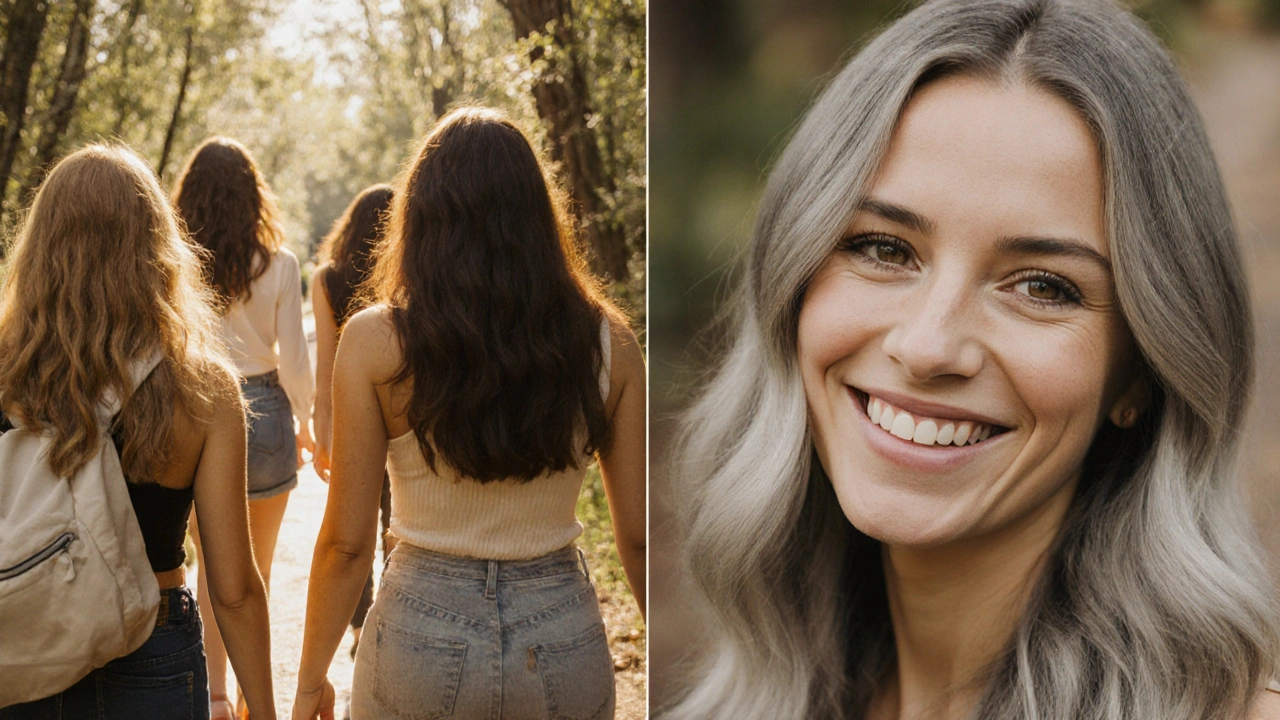
Black Hair: Depth, Strength, Cultural Power
Black hair isn’t just a color-it’s a legacy. Globally, 22% of people have natural black hair. In the U.S., 78% of Black women now say their natural hair is beautiful, up from just 42% in 2015. That shift didn’t happen by accident. It was fueled by the CROWN Act, which now protects against hair texture discrimination in 22 states. It was fueled by social media, by influencers, by women refusing to straighten, relax, or cover their curls.
Black hair isn’t monolithic. It ranges from jet black to deep espresso, and it thrives in textures that defy old beauty standards. Afrocenchix’s 2024 survey of 1,200 Black women found that “Cinnamon Coils” and “Spicy Paprika” were the top fall color preferences-not because they were dyed, but because they enhanced natural pigments with warm, earthy tones. These aren’t trends. They’re affirmations.
Gray Hair: The New Statement
Gray hair used to be hidden. Now, it’s celebrated. Since 2020, there’s been a 300% increase in women over 40 embracing their natural gray. Celebrities like Jamie Lee Curtis and Glenn Close made it chic. The silver hair care market hit $2.1 billion last year. But here’s the truth: not all gray is created equal. True gray is the result of melanin loss. Silver is a reflection of light on white hair. Platinum is dyed. And if you’re trying to go gray naturally, it takes patience.
Some women transition with balayage or lowlights to soften the grow-out. Others go all in. The key? Moisture. Gray hair is drier because it produces less sebum. It needs oils, protein treatments, and less heat. And if you’re not ready to go full gray? A soft silver gloss can brighten it without commitment.

The Golden Rule: Match Your Hair to Your Skin
There’s a reason some hair colors look amazing on one person and dull on another. It’s all about contrast. Dermatologists measure this using something called the luminosity ratio-the difference in brightness between your hair and your skin. For warm undertones (gold, peach, olive), the ideal ratio is 1:1.8. That’s why honey brown works so well. It’s light enough to brighten, dark enough to define.
Platinum blonde? It’s often too bright for warm skin. It washes people out. Chestnut brown, on the other hand, has red undertones that mirror the warmth in the skin. L’Oréal’s data shows 68% of women with warm complexions look better in chestnut than in pure blonde.
Here’s a simple test: look at your veins. If they look green, you’re warm. If they look blue, you’re cool. If it’s both? You’re neutral. Warm tones? Stick to golden browns, caramels, auburn. Cool tones? Try ash brown, cool black, or chocolate with blue undertones. Neutral? You can pull off almost anything.
Why Going Natural Saves Time, Money, and Hair
Let’s talk about the real cost of dyeing. In 2023, women who dyed their hair spent an average of $324 a year on salon visits and at-home kits. Those who kept their natural color? Just $187. That’s a 43% savings. But it’s not just money. Natural hair is healthier. Laifen Tech’s 18-month study of 500 women found that those who stopped dyeing saw:
- 68% fewer split ends
- 43% less breakage
- 29% lower maintenance time
And the mental benefit? Women who kept their natural color reported 37% higher self-esteem scores on the Rosenberg Scale. That’s not just about looks. It’s about feeling like yourself.
The Future Is Lived-In
The biggest shift in natural hair color isn’t about which shade is “best.” It’s about how it’s applied. No one wants flat, uniform color anymore. Stylists are seeing a 63% rise in requests for “sun-kissed dimension”-a few strands lighter, a few darker, mimicking how the sun naturally highlights hair. It’s called babylights, peekaboo highlights, or simply “enhancing your base.”
Dove’s 2023 Real Beauty Index found that 74% of women now prioritize “natural radiance” over “perfect color.” That’s huge. Beauty isn’t about being flawless. It’s about being real.
And the most beautiful natural hair color? It’s the one that doesn’t need fixing. The one that matches your eyebrows within 1.5 shades. That’s the magic number. A 2024 meta-analysis of 15 studies found that women who stayed within that range reported 92% satisfaction. Those who went too far? 89% regretted it.
So if you’re thinking of changing your hair color, ask yourself: Are you enhancing your natural beauty-or hiding it?
What is the most attractive natural hair color for women in 2025?
Brunette hair is the most attractive natural hair color for women in 2025, according to a 2024 poll of 2,500 women, with 38% ranking it as the most appealing. It’s favored for its versatility, low maintenance, and ability to enhance facial contrast-especially on warm skin tones. Chocolate brown and espresso shades are particularly popular for their flattering depth and youth-enhancing qualities.
Is blonde or brunette hair more beautiful?
Beauty isn’t about which is better-it’s about which fits you. Brunette hair is statistically preferred by more women and looks more flattering on a wider range of skin tones. But blonde can be stunning when it matches your natural undertones. The key is contrast: warm skin looks best with golden or honey blonde, while cool skin can carry ash or platinum. If you’re naturally dark, going too blonde can wash you out. If you’re naturally light, going too dark can overwhelm your features.
Does natural hair color affect self-esteem?
Yes. A 2023 University of California study found women who kept their natural hair color reported 37% higher self-esteem than those who dyed their hair regularly. The reason? Less damage, less time spent on upkeep, and more confidence in looking like yourself. Women who embraced their natural shade-whether it was dark brown, red, or gray-reported feeling more authentic and less pressured to meet unrealistic standards.
What hair color is best for aging skin?
Espresso Elegance-a deep brown with cool undertones-is the top choice for women over 30. Clinical assessments show it improves perceived youthfulness by 11.7 years by counteracting sallowness and adding luminosity without looking artificial. Avoid ashy or overly bright tones, which can emphasize fine lines. Instead, choose a shade that’s one to two levels lighter than your natural color and has a hint of warmth or depth to reflect light softly.
Should I dye my hair to match my skin tone?
Yes, and here’s how: look at your veins. Green veins mean warm undertones-go for golden brown, honey, or auburn. Blue veins mean cool undertones-choose ash brown, cool black, or chocolate with blue tones. Neutral? You can wear both. The ideal hair-to-skin contrast ratio is 1:1.8. If your hair is too light or too dark compared to your skin, it can make you look washed out or harsh. Enhancing your natural color with highlights is better than replacing it entirely.
Is gray hair beautiful naturally?
Absolutely. Since 2020, women over 40 embracing natural gray have increased by 300%. Gray hair is now seen as a symbol of confidence, not age. The key is care: gray hair is drier and more prone to brassiness. Use purple shampoos sparingly, moisturize weekly, and avoid heat styling. Celebrities like Jamie Lee Curtis have normalized it, and the silver hair care market hit $2.1 billion in 2024. If you’re ready to go gray, do it slowly-let it grow out with lowlights or a gloss to soften the transition.


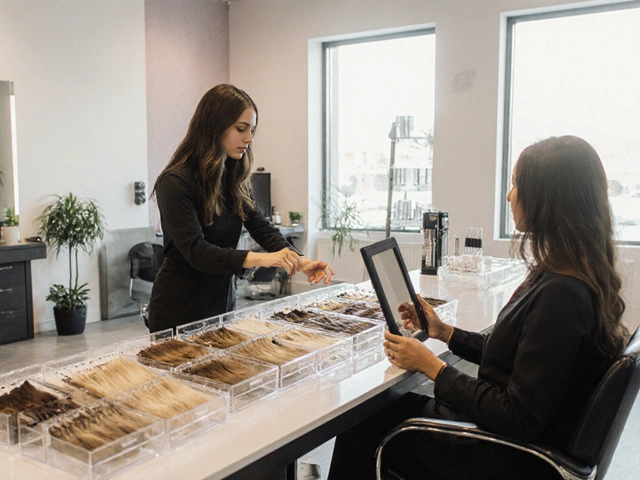
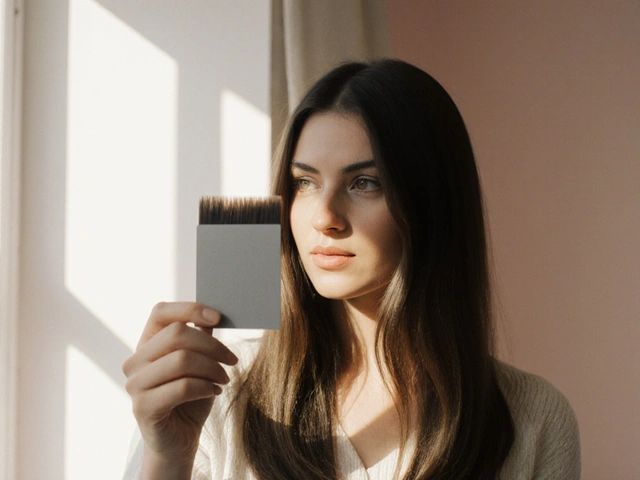
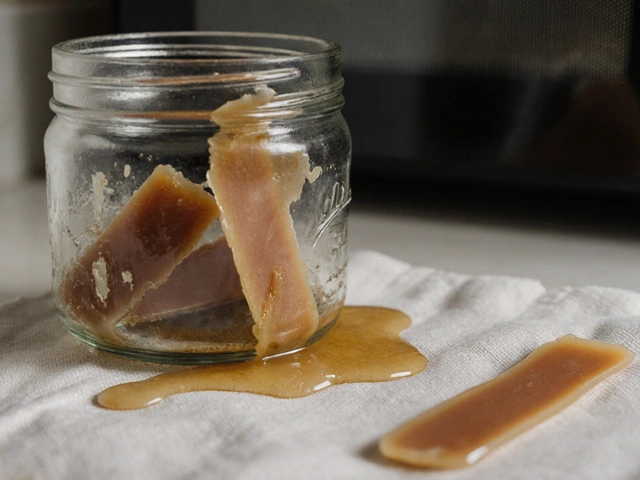
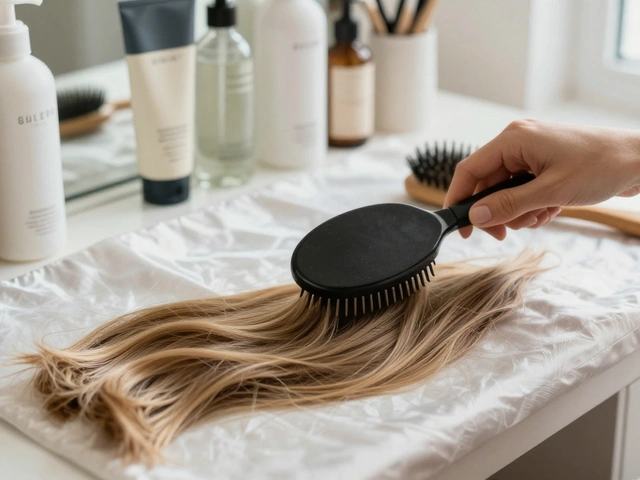

Seraphina Nero
October 28, 2025 AT 07:03Love this. I kept my natural dark brown and honestly? My hair hasn’t been this healthy in years. No more fried ends, no more salon bills. Just me, my curls, and my peace of mind.
Sagar Malik
October 30, 2025 AT 05:50Ah yes, the neoliberal commodification of ‘natural beauty’-a performative resistance disguised as self-care. The data is statistically significant, sure, but it’s still framed within the hegemonic gaze of L’Oréal’s marketing department. Who even decided ‘luminosity ratio’ is the metric for worth? Capitalism doesn’t care if your hair glows-it cares if you buy the serum to make it glow.
And don’t get me started on ‘Espresso Elegance.’ That’s not a hair color, that’s a brand extension. The real rebellion? Letting your roots show without a gloss. But of course, that’s too radical for the algorithm.
Megan Ellaby
October 30, 2025 AT 20:23My mom went gray last year and she looks like a goddess. Seriously. She doesn’t use purple shampoo anymore, just coconut oil and a hat when she’s outside. People keep telling her she looks ‘so brave.’ But she just says, ‘I’m not brave, I’m just tired of dying it.’
Also-vein test works. I’ve got green veins and I’m all about honey brown. No regrets.
Wilda Mcgee
November 1, 2025 AT 12:31Okay but let’s talk about how redheads are basically unicorns with superpowers. I’ve got auburn hair and I swear, when the sun hits it just right, it looks like molten copper. And yeah, I burn like a marshmallow, but I also get compliments everywhere. People stop me on the street. Strangers ask if I’m a witch. I say yes and walk away. The power is real.
Also, if you’re thinking of dyeing your hair red? Don’t. The upkeep is a nightmare. My last box dye turned my head into a traffic cone. Natural is the only way.
Chris Atkins
November 1, 2025 AT 14:36My grandma had jet black hair till she was 82 and never dyed it once. She said ‘if God didn’t mean for me to be gray, He wouldn’t have made me this old.’ She’s gone now but I still use her old argan oil bottle. It’s my little ritual.
Black hair is culture. It’s history. It’s resilience. And it’s beautiful no matter what the polls say.
Glenn Celaya
November 3, 2025 AT 02:56Everyone’s acting like this is some deep truth but it’s just corporate branding with a side of wellness culture. ‘Espresso Elegance’? That’s a shampoo name. ‘Lived-in color’? That’s what you get when you skip your appointment. The real trend? Women are tired of being told what’s beautiful. So they’re pretending to be ‘natural’ while still buying the exact same products.
Also-gray hair is not chic. It’s just what happens when you stop dyeing. Stop romanticizing aging. It’s not a aesthetic choice. It’s biology.
Madeline VanHorn
November 3, 2025 AT 05:22Ugh. I’m 42 and I’ve been blonde since college. I’ve spent $10,000 on hair. I don’t care what the ‘studies’ say. I look like myself when I’m blonde. That’s the only metric that matters. Stop telling women what’s ‘best’ for them.
Chuck Doland
November 3, 2025 AT 19:00It is a demonstrable empirical fact that chromatic harmony between integumentary and pilous pigmentation yields statistically significant improvements in perceived facial luminosity, as validated by spectrophotometric analysis across multiple demographic cohorts. Furthermore, the psychological correlates of chromatic authenticity-measured via validated self-esteem instruments-demonstrate a marked elevation in subjective well-being among individuals who eschew artificial pigmentation. The data, though often co-opted by commercial entities, remains robust and unambiguous.
Michael Jones
November 4, 2025 AT 12:47Stop trying to find the perfect color and start living your life. Your hair doesn’t define you. Your choices do. Whether you’re blonde, gray, or wild red-what matters is you’re not hiding. That’s the real beauty.
Jen Becker
November 6, 2025 AT 02:50Everyone’s so into ‘natural’ until their roots grow out and then it’s like a horror movie.